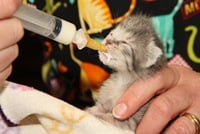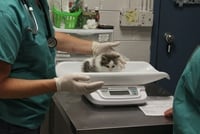
April 2014 by Ellen Jefferson, DVM, Executive Director, Austin Pets Alive!
Audience: Veterinary Team
Originally published January 2013 and updated April 2014.
(This information is intended to be educational in nature. Shelters and rescue groups are expected to work with their veterinarians to determine appropriate treatment for the animals in their care.)
 Having step-by-step protocols for every situation is one of the most important strategies that a high volume shelter can have if the goal is to successfully move a large number of animals from intake to live outcome. That's particularly true for one of the most common conditions we see in shelter dogs and cats - diarrhea.
Having step-by-step protocols for every situation is one of the most important strategies that a high volume shelter can have if the goal is to successfully move a large number of animals from intake to live outcome. That's particularly true for one of the most common conditions we see in shelter dogs and cats - diarrhea.
There are several typical causes of diarrhea in the shelter animals cared for by Austin Pets Alive! (APA). We have identified these causes based on treatment response or failure, testing sample groups and observation. We can further break down those causes based on what type of animal they affect. Within each grouping of animals, we've listed the most common diarrhea causes first, with the least common last:
Neonatal Diarrhea:
- GI flora changes in response to switch from mothers' milk to formula, or from formula to gruel
- Coccidia, other parasites
- Viral (corona, panleukopenia, etc.)
Juvenile (eating on their own, less than 4 months of age) Diarrhea:
- Coccidia, giardia and other parasites
- Viral (parvo, panleukopenia, corona)
- Food change
Young Adult Diarrhea:
- Stress/excitement
- Giardia or coccidia
- Diet change
- Viral
- Other (autoimmune, Inflammatory Bowel Disease, allergies, etc.)
Adult Diarrhea:
- Stress/excitement
- Diet change
- Parasites
- Other
To further back up our assumptions based on our own findings, there was one study of pathogen-related diarrhea 1 that showed 68% of tested shelter dogs with diarrhea were positive for giardia and 15% for coccidia. Of shelter cats with diarrhea, 11% tested positive for coccidia, but the majority tested negative for all viral and protozoal pathogens.
This study did not test for parasites such as roundworms, hookworms or whipworms which are very common in young animals, and even with negative fecal examinations and deworming, they should be considered highly possible to be present.
Statistical analysis of the causes of diarrhea is important because it shapes how a shelter can treat the group in the most efficient and cost effective way possible. If a large majority of the animals who have diarrhea are likely to be suffering from the same cause, then that treatment should be the first line of defense against diarrhea in all dogs and cats for the sake of efficiency and lifesaving. For most treatment of diarrhea, there is very little risk in terms of harm to the animal or cost in using the treatment for that problem on animals who have diarrhea, whether or not they have the problem.
With that philosophy in mind, we have created protocols for the veterinary care staff to follow, which outline what to do to address the most common causes of diarrhea.
Our protocols are not meant to replace care by a veterinarian, but instead to demonstrate a simple method of treating the most common types of diarrhea in an efficient manner, saving the veterinarian's time and energy for the most pressing cases that need their expert attention. In a shelter setting, where resources are often extremely limited, it is important to use those resources in the most cost and time effective way possible.
For example, in private practice, almost every animal with diarrhea would have tests run to determine the cause of diarrhea before treatment. In the reality of a shelter, running fecal floatation tests and direct tests on each animal is cumbersome and time-consuming (about 10 minutes each). Additionally, such testing may inadvertently spread disease due to staff handling of infected feces in a high-volume clinic setting. It slows down the lifesaving capacity of high-volume clinics to employ routine, private practice, individualized care measures that are part of the practice's business model.
That's why standardized protocols to treat the majority of the animals with similar symptoms are a key strategy for handling the sheer volume of animals that need to be saved. Since there are so many causes of diarrhea in shelter animals, and they vary by group and situation, at Austin Pets Alive! we have developed protocols to treat each animal when diarrhea occurs based on the most likely cause for which group that animal fits. The vast majority treated in this manner will respond to these protocoled treatments. Staff, fosters and caretakers can rely on a transparent, consistent treatment plan which helps to ensure consistency, accurate communication and follow-up.
If we can treat or prevent most causes of diarrhea with a protocoled response, we can maximize our time on the animals needing more concentrated care. Only the animals who do not respond to or worsen while on the protocoled treatment are elevated to more individualized care with the veterinary staff. The veterinarian can and should do routine rounds on all patients to ensure oversight and compliance, which is much simpler when every animal's care follows set protocols.
Getting Started
The first step of any medical protocol is to assess the symptoms of the animal. We characterize the stool, ensure that the animal does not have other, more life-threatening symptoms, and then provide empirical treatment. (Note: protocols for sanitation, not addressed here, also ensure that all caregivers are following standard disease control, such as isolation of affected animals from unrelated animals, washing hands or wearing gloves between animals and cleaning with appropriate disinfectants - all essential in a shelter environment.)
The Protocols
 Neonates: At intake into APA, we treat neonatal puppies and kittens who have no mother with a single penicillin G injection in an effort to pre-empt bacterial imbalance as neonates switch from mothers milk to formula. Before we started this practice, we found that upwards of 80% of babies developed diarrhea after the diet change. They also receive a dose of routine pyrantel pamoate (Strongid). A baby can die quickly from diarrhea, and providing this at intake prevents many from ever developing it. We have found that by using this pre-emptive treatment, we have far fewer cases of neonatal diarrhea from diet change than we did before we began treating prophylactically.
Neonates: At intake into APA, we treat neonatal puppies and kittens who have no mother with a single penicillin G injection in an effort to pre-empt bacterial imbalance as neonates switch from mothers milk to formula. Before we started this practice, we found that upwards of 80% of babies developed diarrhea after the diet change. They also receive a dose of routine pyrantel pamoate (Strongid). A baby can die quickly from diarrhea, and providing this at intake prevents many from ever developing it. We have found that by using this pre-emptive treatment, we have far fewer cases of neonatal diarrhea from diet change than we did before we began treating prophylactically.
 When diarrhea occurs in neonates, quick action is necessary to prevent malnutrition, dehydration, hypoglycemia and death - much more so than in other animals. A delay of even six hours can cause death. These little babies suffer imperceptible (to the naked eye) weight loss and signs of dehydration before death, and so with any symptom of diarrhea, it is critical to notice and treat immediately. We don't address general neonatal care here, but weighing the animal multiple times per day is also essential to catch illness early enough to intervene. The treatment protocol that our team uses for what we term "common diarrhea" in neonates is:
When diarrhea occurs in neonates, quick action is necessary to prevent malnutrition, dehydration, hypoglycemia and death - much more so than in other animals. A delay of even six hours can cause death. These little babies suffer imperceptible (to the naked eye) weight loss and signs of dehydration before death, and so with any symptom of diarrhea, it is critical to notice and treat immediately. We don't address general neonatal care here, but weighing the animal multiple times per day is also essential to catch illness early enough to intervene. The treatment protocol that our team uses for what we term "common diarrhea" in neonates is:
Diarrhea alone (appetite present and no vomiting):
- Penicillin G injection if it has been longer than 48 hours since injection at intake
- If no improvement in 12 hours, start medications below
- Marquis (ponazuril)
- Panacur (fenbendazole)
- Subcutaneous fluids
If no improvement in 24 hours or if patient worsens (not eating, lethargic, vomiting, fading), start protocol below:
- Contact vet team for immediate appointment
- Isolate the pet in a cage bank located away from other animals
- Ensure proper disease control is used, such as the use of separate or individualized disposable gloves and smock per litter, and use of trifectant spray on any and all communal areas between litters
If vet appointment is not immediate:
- Force feed every 4 hours until eating on own
- Test for parvo/panleukopenia
- Consider baytril injections subcutaneously
Juveniles and Adults: We treat every animal, regardless of age, with pyrantel pamoate at intake, and then again in 2 weeks.
The protocol for any animal over 6 weeks of age who is eating well and has stool that is loose but still formed/not watery:
- Ensure that pet has received routine dewormer (Strongid or Panacur) appropriately
- Do a trial of kaolin and/or bland diet for 24 hours and reassess
If the pet is eating well, but the stool is watery:
- Start metronidazole (Flagyl)
If stool is yellow, with or without a grainy texture:
- Start ponazuril; extend if diarrhea improves but then relapses immediately after 5 day course
If the pet is a puppy and eating well but bloody diarrhea is present:
- Do a parvo test and then start ponazuril and metronidazole, as above
If no improvement in 48 hours or if patient worsens:
- See vet staff for fecal and physical exam
If an animal has other symptoms such as pain, fever, vomiting or anorexia:
- Have vet evaluate without delay
 In a high-volume environment, it is critical that the majority of the animals are treated in the same consistent way even if their symptoms vary slightly. If each animal had his or her own different treatment plan, it would become too much for a small medical team to handle and keep track of. Having a routine method of dealing with each general grouping of problems enables the veterinarian to focus on the bigger issues that seem too big when there are thousands of smaller problems with individual solutions each year.
In a high-volume environment, it is critical that the majority of the animals are treated in the same consistent way even if their symptoms vary slightly. If each animal had his or her own different treatment plan, it would become too much for a small medical team to handle and keep track of. Having a routine method of dealing with each general grouping of problems enables the veterinarian to focus on the bigger issues that seem too big when there are thousands of smaller problems with individual solutions each year.
With consistent, easy protocols, most animals will fit the mold and do very well. For the ones who don't, there needs to be a clear way to communicate when an animal truly needs the veterinarian's attention immediately. Once the pet reaches the veterinarian, it is also critical that there are protocols and consistency in how each veterinarian in a multi-veterinarian clinic addresses those needs to preserve efficiency and scalability.
For Austin Pets Alive! the solution for dealing with diarrhea in a shelter is a great example of all the work we do. Two main themes have allowed us to treat thousands of animals on a shoestring: compartmentalizing the work and automating processes. We do not have the perfect solutions for diarrhea, and end up with our fair share of cases that do not respond to the protocols, but we have limited those to a manageable few by relying on our easy-to-follow standardized processes.
References
1. M.E. Spindel. "Prevalence of Select Infectious Agents in Diarrhea Samples From Dogs and Cats in North Central Colorado Animal Shelters." American College of Veterinary Internal Medicine (ACVIM) 2006.
Dr. Ellen Jefferson, DVM
Dr. Jefferson is a leader in Austin's No-Kill effort. She joined Austin Pets Alive as Executive Director in 2008 and began applying best practices in efficiency and operations to resolve Austin's previously high euthanasia rate. Within the first year of her leadership, Austin Pets Alive reduced euthanasia in Austin by more than 20%, and in 2011, Austin reached a 91% save rate. She founded EmanciPET in 1999 and has been its Director for nine years. Before that she worked nights as an emergency room veterinarian, volunteering during the daytime at the local animal shelter. She graduated from Virginia Maryland College of Veterinary Medicine in 1997.
Since 2008, Dr. Jefferson has been the Mayor's appointee to Austin's Animal Advisory Commission, and in 2009 she was a finalist for the Austin Under Forty Awards. She also served on the Nation Spay/Neuter Task Force from 2007-2009 and has had work published in the peer-reviewed veterinary literature.